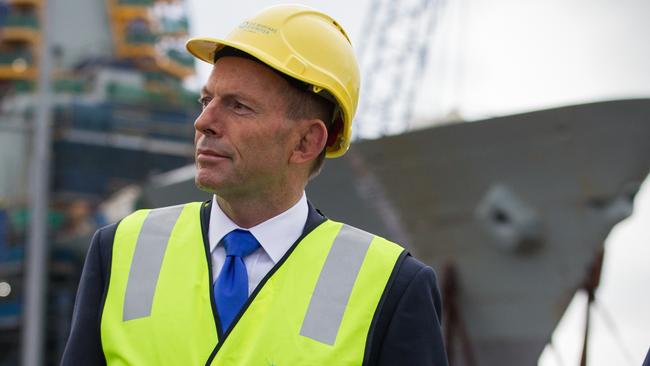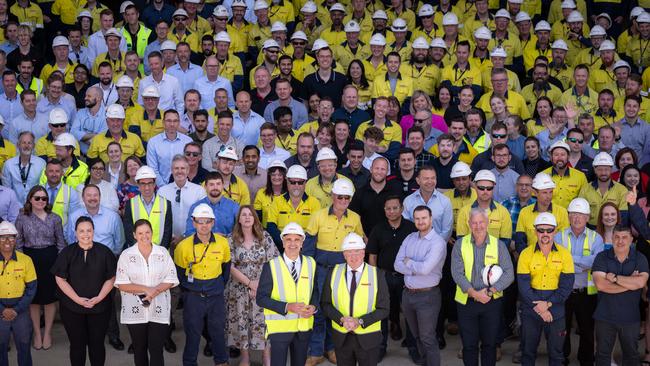Analysis: Adelaide naval shipbuilding history’s lowlights repeating in Hunter frigates fiasco | Paul Starick
I’ve been watching the ups and downs of Adelaide shipbuilding for 30 years and history is repeating itself in the Hunter frigates farce, writes Paul Starick.
Opinion
Don't miss out on the headlines from Opinion. Followed categories will be added to My News.
The shambolic indecision and ineptitude that has plagued Adelaide naval shipbuilding for a generation is repeating in an endless loop.
The critical release of a surface fleet review within days will determine the future of the $45bn Hunter Class frigate project at Osborne Naval Shipyard and, with it, the latest promise of a continuous naval shipbuilding program there.
Having written about submarines and shipbuilding at Osborne for more than 30 years, I’ve documented a litany of overcooked ambition, misplaced promises and policy misadventures.
The Collins Class submarines, for example, were plagued by problems with combat and other systems.
They were viciously branded as dud subs, noisier than a rock concert.
Then, thanks to a committed Adelaide workforce, they were re-engineered to become world-leading diesel-electric submarines, capable of “sinking” a US submarine in exercises.
A 2004 story I wrote about the Australian Submarine Corporation winning the nation’s top engineering award was headlined “Dud subs no more”.
Fast forward 20 years and there’s yet another crisis centred on Osborne.
Ironically, the latest fiasco involves the future frigate program committed to almost a decade ago by the-then prime minister Tony Abbott as the linchpin of a continuous shipbuilding program.

Unveiling a $89 billion naval construction program in August, 2015, Mr Abbott’s rhetoric was a likely forerunner to Defence Minister Richard Marles’ promises when he releases the naval surface fleet review in a few days’ time.
“This critical investment will generate significant economic growth and preserve South Australian jobs. This strategy will transform Australia’s naval shipbuilding industry and put it on to a sustainable long-term path, giving the workforce certainty into the future,” Mr Abbott said, when I interviewed him.
“It’s the first time any Australian government has committed to a permanent naval shipbuilding industry.”
He then attacked the former Labor government for creating a workforce “valley of death” by failing to commission a single naval warship from an Australian shipyard during its six years in office.
Expect Mr Marles to do the same but, of course, attack Mr Abbott and his Coalition successors.
Like many times before, debate over the frigates’s future has included the Hunter platform being undermined by various experts.
Among these, former navy chief David Shackleton, in a 2022 Australian Strategic Policy Institute report, called for the project to be stopped and redirected
History also is repeating with the confusion over project objectives.
State governments have achieved success by pushing the national defence and strategic interest of Adelaide-based shipbuilding, rather than pitifully pleading for a major defence contract as a make-work scheme.
Like Mike Rann did with a successful pitch for air warfare destroyer construction in 2005, Premier Peter Malinauskas has, rightly, chosen to argue the national interest case.

More than 1800 BAE Systems Australia workers are involved with the Hunter project, centred on Osborne, which presently involves building nine ships.
Addressing them on November 6, BAE Systems Australia managing director maritime Craig Lockhart urged them to continue “second-to none” performance in the face of continued speculation about the project’s future.
This speculation has included at least six ships to be built at Osborne, costing between $4.5bn and $5bn each, to a total of 16 – eight using a 96-missile design revealed last November and the other eight to the original 32-missile design.
The latter seems likely only if a substantial tranche was unfunded but loose promises were delivered to create the foundation – or facade – of a continuous shipbuilding program.
The challenge now is for the Albanese government to deliver upon its oft-repeated promise of a continuous Adelaide naval shipbuilding program – or be recorded in history as yet another that was all talk and no action.





